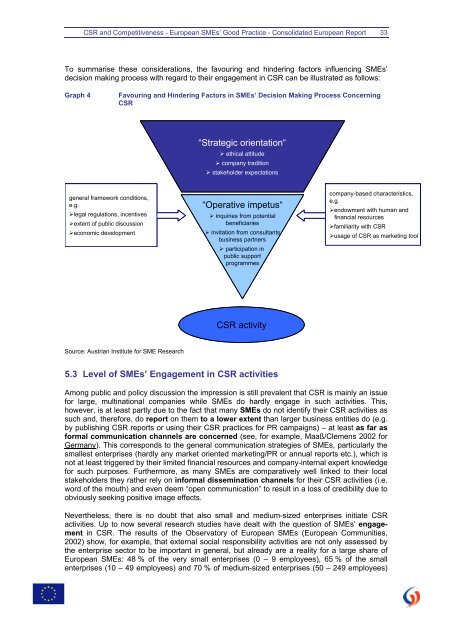CSR and Competitiveness European SMEs - KMU Forschung Austria
CSR and Competitiveness European SMEs - KMU Forschung Austria
CSR and Competitiveness European SMEs - KMU Forschung Austria
Create successful ePaper yourself
Turn your PDF publications into a flip-book with our unique Google optimized e-Paper software.
<strong>CSR</strong> <strong>and</strong> <strong>Competitiveness</strong> - <strong>European</strong> <strong>SMEs</strong>’ Good Practice - Consolidated <strong>European</strong> Report 33<br />
To summarise these considerations, the favouring <strong>and</strong> hindering factors influencing <strong>SMEs</strong>’<br />
decision making process with regard to their engagement in <strong>CSR</strong> can be illustrated as follows:<br />
Graph 4 Favouring <strong>and</strong> Hindering Factors in <strong>SMEs</strong>’ Decision Making Process Concerning<br />
<strong>CSR</strong><br />
general framework conditions,<br />
e.g.<br />
�legal �legal regulations, incentives<br />
�extent �extent of public discussion<br />
�economic �economic development<br />
Source: <strong>Austria</strong>n Institute for SME Research<br />
“Strategic orientation“<br />
�� ethical attitude<br />
�� company tradition<br />
�� stakeholder expectations<br />
“Operative impetus“<br />
�� inquiries from potential<br />
beneficiaries<br />
�� invitation from consultants<br />
business partners<br />
�� participation in<br />
public support<br />
programmes<br />
<strong>CSR</strong> activity<br />
5.3 Level of <strong>SMEs</strong>’ Engagement in <strong>CSR</strong> activities<br />
company-based characteristics,<br />
e.g.<br />
�endowment �endowment with human <strong>and</strong><br />
financial resources<br />
�familiarity �familiarity with <strong>CSR</strong><br />
�usage �usage of <strong>CSR</strong> as marketing tool<br />
Among public <strong>and</strong> policy discussion the impression is still prevalent that <strong>CSR</strong> is mainly an issue<br />
for large, multinational companies while <strong>SMEs</strong> do hardly engage in such activities. This,<br />
however, is at least partly due to the fact that many <strong>SMEs</strong> do not identify their <strong>CSR</strong> activities as<br />
such <strong>and</strong>, therefore, do report on them to a lower extent than larger business entities do (e.g.<br />
by publishing <strong>CSR</strong> reports or using their <strong>CSR</strong> practices for PR campaigns) – at least as far as<br />
formal communication channels are concerned (see, for example, Maaß/Clemens 2002 for<br />
Germany). This corresponds to the general communication strategies of <strong>SMEs</strong>, particularly the<br />
smallest enterprises (hardly any market oriented marketing/PR or annual reports etc.), which is<br />
not at least triggered by their limited financial resources <strong>and</strong> company-internal expert knowledge<br />
for such purposes. Furthermore, as many <strong>SMEs</strong> are comparatively well linked to their local<br />
stakeholders they rather rely on informal dissemination channels for their <strong>CSR</strong> activities (i.e.<br />
word of the mouth) <strong>and</strong> even deem “open communication” to result in a loss of credibility due to<br />
obviously seeking positive image effects.<br />
Nevertheless, there is no doubt that also small <strong>and</strong> medium-sized enterprises initiate <strong>CSR</strong><br />
activities. Up to now several research studies have dealt with the question of <strong>SMEs</strong>’ engagement<br />
in <strong>CSR</strong>. The results of the Observatory of <strong>European</strong> <strong>SMEs</strong> (<strong>European</strong> Communities,<br />
2002) show, for example, that external social responsibility activities are not only assessed by<br />
the enterprise sector to be important in general, but already are a reality for a large share of<br />
<strong>European</strong> <strong>SMEs</strong>: 48 % of the very small enterprises (0 – 9 employees), 65 % of the small<br />
enterprises (10 – 49 employees) <strong>and</strong> 70 % of medium-sized enterprises (50 – 249 employees)




